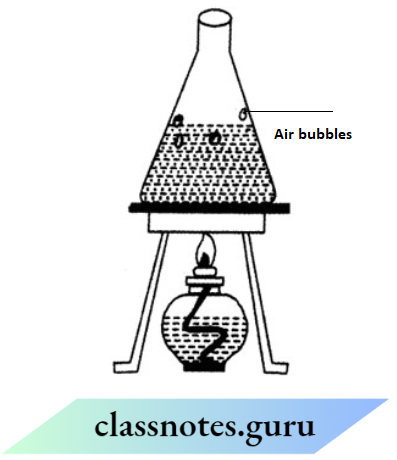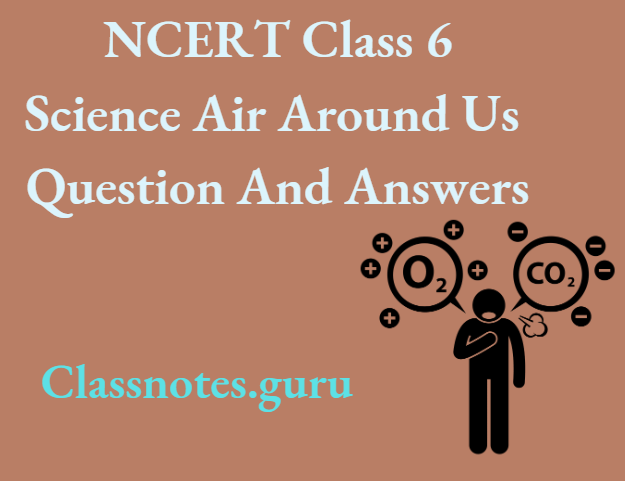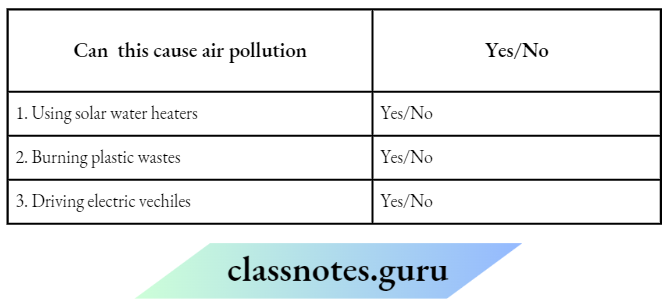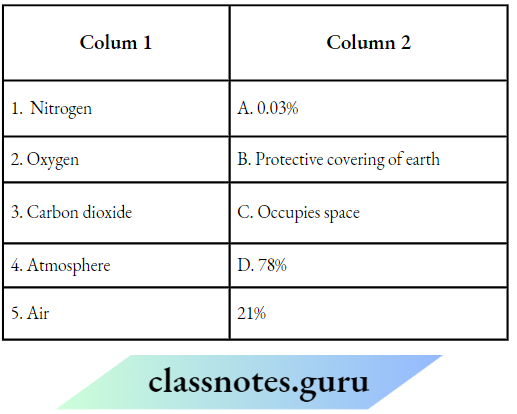NCERT Class 6 Science Chapter 11 Air Around Us Long Question And Answers
Question 1. How will you show that air is dissolved in water?
Answer:
Take some water in a glass vessel or beaker. Heat it slowly on a tripod stand well before the water begins to boil. Look carefully at the inner surface ofthe vessel, you will see tiny bubbles inside. These bubbles come from the air dissolved in water

Question 2. Observe the figure given below depicting the distribution of some components present In air and answer the following questions:
Read and Learn More Class 6 Science Question And Answers

- Identify all the components.
- What purpose is served by the component
- Do the values or percentages of these components vary?
Answer:
1.
- Nitrogen – 78%
- Oxygen – 21%
- CO2, water vapour- 0.03%
- Other gases and dust particles – 1%
2. The component is oxygen. It is used by humans and animals for respiration. It also helps in combustion/ burning.
3. Yes, the composition ofair is not always the same. It changes slightly from place to place.
Question 3. Explain the following observations briefly.
- A firkin does not rotate in a closed area
- The arrow of weather cock points towards a particular direction at a particular moment
- An empty glass Is not empty
- Breathing through the mouth may harm you
Answer:
- Motion offers are based on the pressure/force applied by air on the blades of the first. A firkin does not rotate in a closed area because of a lack of air movement.
- The arrow of the weather cock points towards a particular direction as it shows the direction in which the air is moving at that place at a particular moment.
- An empty glass in feet is not empty. It is filled with air. Which is present everywhere.
- Breathing through the mouth may harm us because we may inhale dust,f present in the air which is harmful
Question 4. Pahell kept some water In a beaker for heating. She observed that tiny bubbles appeared before the water started to boil. She boiled the water for about 5 min filled It In a bottle upto the brim and kept the bottle airtight till cooled down to room temperature.
- Why did the tiny bubbles appear?
- Do you think tiny bubbles will appear on heating the water taken out from the bottle? Justify your
Answer:
- Air is dissolved in water in the form of oxygen. Tiny bubbles appear when air present in the water escapes from boiling it.
- No, tiny bubbles will not appear again as there is no dissolved air in this water after boiling.
Question 5. Explain what makes the carbon dioxide gas present in the air necessary for all in the atmosphere.
Answer:
The presence of small amount of carbon dioxide gas in the atmosphere is essential for the growth and existence of living beings.
- The desirable proportion of carbon dioxide in the atmosphere is 0.03%.
- The importance of carbon dioxide in the atmosphere is as follows
- It leads to the heating of the Earth and its atmosphere which is essential for our survival
- It takes part in the photosynthesis process carried out by green plants to prepare their food

Question 6. Write a few sentences for an imaginary situation if any of the following gases disappear from the atmosphere.
- Oxygen
- Nitrogen
- Carbon dioxide
Answer:
- There will be no life on the Earth. Oxygen is vital for life. It helps in burning, respiration, photosynthesis, etc. Oxygen is a basic need of all living beings.
- Nitrogen is utilised by plants for their growth and development in the absence of nitrogen no plants will survive and hence, no life is possible on Earth.
- Carbon dioxide is needed for photosynthesis which occurs in green plants. In its absence, plants will not be able to prepare their food and hence, there will be no life on the Earth.
Question 7. Humans and animals use oxygen for respiration and plants require carbon dioxide for photosynthesis. How are these two processes related?
Answer:
- Humans and animals use oxygen present in the environment to carry out respiration and release CO2 as a byproduct of this process.
- Plants perform photosynthesis by using this CO2 present in the atmosphere accumulated due to the activities of humans and animals. They release oxygen as a byproduct which also gets out in the atmosphere.
- Plants depend on humans and the activities performed by them like burning of fuels, etc. for CO2 and humans depend on plants for a continuous oxygen supply. Thus, these two processes maintain a unique balance between O2 and CO2 concentration in our environment
Question 8. Which of these actions can cause air pollution? Circle ‘Yes’ or ‘No’ for the correct response

Answer:
- No
- Yes
- No
Question 9. Observe the given figure and answer the following question?

- What Is covering the nose and mouth of the policeman?
- Why is he putting a cover on his nose?
- Can you comment on the air quality of the place as shown in the figure
Answer:
- The mask covers the nose and mouth of the policeman.
- The policeman is putting a cover on his nose to himself from dirt/polluted air produced by vehicles on the road.
- The air quality of the place is not good. It is due to the smoke and gases emitted by the automobiles along with dust particles present in the air
NCERT Class 6 Science Chapter 11 Air Around Us Short Question And Answers
Question 1. What should Sumit keep the same for the activity? Circle ‘Yes’ or ‘No’ for the correct response.

Answer:
- Yes
- No
Question 2. Make sentences using the given set of words.
- 99%, oxygen, nitrogen, and air, together
- Respiration, dissolved, animals, air, aquatic
- Air, wind, motion, called
Answer:
The correct sentences are:
- Oxygen and nitrogen together make up 99% ofthe air.
- Aquatic animals use dissolved air for respiration.
- Air in motion is called wind.
Question 3. Ravi fills a steel vessel with water and starts heating it in an oven. He notices small bubbles at the bottom of the vessel after some time.

Question 4. Identify the major components of air present in the
- Inhaled air
- Exhaled air
Answer:
- Oxygen
- Carbon dioxide
Question 5. How does air play an important role in the water cycle?
Answer:
- The water vapour from lakes and sea after evaporation is carried into the atmosphere by air.
- Here, it gets condensed and finally falls back on Earth as a ram. And this cycle continues.
Question 6. Why does a lump of cotton wool shrink in water?
Answer:
- Lump of cotton wool has air among gaps of cotton fibres.
- When dipped in water, air from these gaps is replaced by water.
- The cotton lump becomes heavy and also shrinks due to the removal of air gaps.
Question 7. Why do mountaineers carry oxygen cylinders while climbing high mountains?
Answer:
- As we go higher in the atmosphere, the air gets rarer, consequently, oxygen is also reduced.
- This is why oxygen cylinders are carried by mountaineers, to be able to breathe in a lack of oxygen.
Question 8. The transparent glass of windows appers hazy if not wiped why?
Answer:
- Dust particles sit on the surface ofthe glass windows.
- Other components in the air such as moisture (water vapours) also get collected and the window appears hazy.
Question 9. How do plants and animals help each other in the exchange of gases in the atmosphere?
Answer:
- There is an interdependence of plants and animals on each other for the exchange of gases.
- Plants take carbon dioxide and give out oxygen to the atmosphere.
- Animals inhale this oxygen and give out carbon dioxide to the atmosphere.
- Therefore, plants and animals help each other in the exchange of gases in the atmosphere.
Question 10. Air takes the shape, smell, etc. of the object/ place it is present in. Explain?
Answer:
- Air does not have a fixed shape or size of its own because it is a gaseous mixture whose particles are very loose, thus not able to form a fixed shape
- If air is blown in a balloon of a round shape, it takes its shape. Similarly, air can be enclosed in packets of chips different in shape and size.
- Like water, air also has no smell. It carries the odour of whatever is present in the surroundings. We can smell a nice perfume or a bad smell because air carries the smell.
Question 11. When an empty glass bottle is inverted and inserted into a trough filled with water, water does not enter the bottle. Specify.
Answer:
Water does not enter into an inverted glass bottle because even when the bottle appears empty, it’s not. Air is present inside the bottle or any other area which is empty.
All the space in the bottle is occupied by air. This air prevents the water from entering inside the bottle. As we tilt the bottle, air present inside moves out. As air comes out, the space becomes empty allowing the entry of water. The space vacated by leaving ofair is then occupied by water.
Question 12. During any fire incident, it is advised to
- Wrap a towel or woollen blanket over the burning object.
- Use a fire extinguisher to stop the fire.
Why are these methods advised? Give reasons.
Answer:
- Fire or burning is supported by oxygen. To stop it, The towel or woollen blanket used cuts off the supply of oxygen, which supports burning. As this supply is cut out, the fire eventually stops.
- A fire extinguisher contains carbon dioxide gas, which does not support burning. So, when a fire extinguisher is used over the area, CO2 cuts off the oxygen supply from the air causing the fire to be extinguished
Question 13. Garima observed that when she left her tightly capped bottle full of water In the open sunlight, tiny bubbles formed all around inside the bottle. Help Garima to know why It so happened.
Air is dissolved in water in the form of oxygen. When a water bottle is left in the open sunlight, tiny bubbles form all around inside the bottle because air dissolved in water starts escaping in the form of tiny bubbles due to heat from the Sun.
Question 14. On a Sunday morning, Paheli’s friend visited her home. She wanted to see some flowering plants in the nearby garden. Both of them went to the garden. While returning from the garden, they also observed some flowering plants on the roadside. But to their surprise, they found that the leaves and flowers of these roadside plants were comparatively very dull. Can you help them to know why?
Answer:
The leaves and flowers of the roadside plants are very dull because the air along the roadside is polluted with air pollutants due to emissions of harmful gases and dust particles from vehicles and industries, etc. Thus, the roadside plants had probably some dust and soot deposited on them. This made them appear dull
Question 15. Why is it safer to breathe through the nose than through the mouth?
Answer:
- Fine hair and mucus are present in our nostrils.
- They prevent the dust particles from entering the respiratory system.
- Hence, it is safer to breathe through the nose than through the mouth.
NCERT Class 6 Science Chapter 11 Air Around Us Very Short Questions and Answers
Question 1. What do you have in your fist when you close it?
Answer: Though we might think, there is nothing, when we close our fists, air gets trapped in the spaces between our fingers.
Question 2. What kind of a mixture is air?
Answer: Air is a mixture of many gases. The major components ofair are gases like oxygen, nitrogen, etc water vapour and dust
Question 3. Why does a policeman wear a mask, while regulating traffic?
Answer: There are so many dust particles in the air in crowded traffic. A mask protects the respiratory system ofthe policemen
Question 4. Why during an accident or fire, one is advised to wrap a woollen blanket over a burning object?
Answer: By wrapping the object with the woollen blanket, the oxygen supply is cut off and the fire gets extinguished.
Question 5. Will the tiny air bubbles seen before water boil, also appear if we do this activity by reheating boiled water kept in an airtight bottle?
Answer: If boiled water kept in an airtight container is reheated, the bubbles do not appear again as dissolved air is already escaped while heating before.
Question 6. We say that air Is present everywhere. Have you ever seen it? what makes you say so?
Answer: No. air cannot be seen, but it can be felt during wind, fluttering ofleaves, etc.
Question 7. A place where no air is present will be called what? Give example.
Answer: A place without air is called a vacuum,
Example: Space.
Question 8. Oxygen occupies how many parts of the air?
Answer: Oxygen occupies about l/5th part ofthe air.
Question 9. Oxygen and nitrogen form 99% of the air. Rest 1% is constituted by which components?
Answer: 1% of air includes carbon dioxide (CO2), water vapours, helium, hydrogen, dust particles and smoke.
Question 10. Do you know the reason why mountaineers carry oxygen cylinders with them?
Answer: As we go up above the sea level, oxygen decreases at higher altitudes which causes breathing problems. So mountaineers carry oxygen cylinders with them.
Question 11. Is air necessary for burning? Give a reason for your answer.
Answer: Yes. because oxygen present in the air supports burning.
Question 12. Gases are present in certain ratios in the air. Can you tell the relative proportions of nitrogen and oxygen in the air?
Answer: Nitrogen and oxygen are present in the ratio of 4:1 by volume in air.
Question 13. Name the major part of air that does not support burning.
Answer: Nitrogen is the major part of the air which does not support burning.
Question 14. Name the sources of carbon dioxide in the air.
Answer: Respiration by animals and plants and the burning of fuel etc. are the sources of carbon dioxide.
Question 15. During rainfall, the spaces between soil particles are filled with water. How do the organisms of soil breathe?
Answer: Organisms present in soil come out of their holes and burrows for breathing.
Question 16. Give a reason why factories have tall chimneys.
Answer: Tall chimneys take the smoke produced by factories high up in the air to reduce harmful effects on the ground.
Question 17. In many musical instruments, air plays an important role. Can you name such instruments?r
Answer: Air plays an important role in several musical instruments such as the flute, trumpet, harmonium, etc.
Question 18. Traffic policemen use the masks for which reason?
Answer: To prevent inhalation of smoke given out by automobiles, traffic policemen use masks
Question 19. Which gas in the atmosphere is essential for respiration?
Answer: Oxygen is essential for respiration.
Question 20. The layer of air around the Earth is known as
Answer: Atmosphere
Question 21. The component of air used by green plants to make their food is
Answer: Carbon dioxide
Question 22. Where do the bubbles come from?
Answer: Air is dissolved in water. When water is heated, the air escapes. Hence, the bubbles form
NCERT Class 6 Science Chapter 11 Air Around Us Fill In The Blanks
Question 1. As we move higher in the atmosphere, the air gets ________________
Answer: Rarer
Question 2. Aquatic animals use dissolved ________________ in water for respiration
Answer: Oxygen
.
Question 3. The component of air used by green plants to make their food is________________
Answer: Carbon dioxide
Question 4.________________in factories take the harmful smoke and gases away from our noses.
Answer: Chimneys
Question 5. Windmills are used to generate ________________
Answer: Electricity
Question 6. The________________ particles can be seen moving in a beam of sunlight in a dark room.
Answer: Dust
Question 7. The envelope of air that surrounds the Earth is called ________________
Answer: Atmosphere
Question 8. The presence of ________________in air is important for the water cycle in nature
Answer: Water vapours
NCERT Class 6 Science Chapter 11 Air Around Us True/False
Question 1. Air helps in the movements of sailing yachts and gliders, but plays no role in the flight of birds and aeroplanes
Answer: False
Air also helps in the (light of birds and aeroplanes
Question 2. The composition of air is always the same.
Answer: False
The composition ofair is not always the same.
Question 3. Respiration can occur only in the presence of nitrogen
Answer: False
Nitrogen has no role in the process of respiration
Question 4. Nitrogen present in the air supports the process of burning.
Answer: False
Nitrogen does not support the process of burning
Question 5. Green plants need carbon dioxide gas to make food.
Answer: True
Question 6. Plants produce oxygen during the process of making their food.
Answer: True
Question 7. Aquatic animals and plants use dissolved nitrogen to survive in water.
Answer: False
Question 8. The amount of air increases as we go up.
Answer: False
Question 9. CO2 is important for green plants.
Answer: True
NCERT Class 6 Science Chapter 11 Air Around Us Assertion-Reason Questions
The following questions consist of two statements. Assertion and Reason (R). Answer these question by selecting the appropriate option given below
- Both A and R are true and R is the correct explanation of A
- Both A and R are true, but R is not the correct explanation of A
- A is true, but R is false
- A is false, but R is true
Question 1.
Assertion (A): Carbon dioxide and oxygen are involved in respiration.
Reason (R): The plants and animals consume carbon dioxide and oxygen respectively
Answer: 1. Both A and R are true and R is the correct explanation of A
Question 2.
Assertion (A): We feel comfortable on a windy day.
Reason (R): Wind is caused by the movement of air.
Answer: 2. Both A and R are true, but R is not the correct explanation of A
Both A and R are true, but R is not the correct. explanation of A. The correct explanation is that The movement ofair causes wind, but it does not explain why we feel comfortable on a windy day. We feel comfortable because the moving air helps in the evaporation of sweat from our body thereby giving us a cooling effect
Question 3.
Assertion (A): Plants release carbon dioxide into the atmosphere.
Reason (R): Plants make their food by the process of photosynthesis.
Answer: 4. A is false, but R is true
A is false, but R is true. This can be corrected as Plants release oxygen into the atmosphere and they consume carbon dioxide during photosynthesis.
Question 4.
Assertion (A): Tire pressure of air decreases with height.
Reason (R): Tire amount of air decreases as we go up
Answer: 1. Both A and R are true and R is the correct explanation of A
Question 5.
Assertion (A): Plants can absorb nitrogen in the form of nitrates.
Reason (R): Plants cannot use nitrogen directly from air.
Answer: 1. Both A and R are true and R is the correct explanation of A
Question 6.
Assertion (A): Bubbles form when soil is added to water.
Reason (R): Air is dissolved in soil
Answer: 1. Both A and R are true and R is the correct explanation of A
NCERT Class 6 Science Chapter 11 Air Around Us Match The Columns
Question 1. Match the Column 1 with Column 2

Answer: 1-D, 2- C, 3- E, 4- A, 5- B
Question 2. Match the Column 1 with Column 2

Answer: 1-D, 2- E, 3- A, 4- B, 5- C
Question 3. Match the Column 1 with Column 2

Answer: 1-E, 2- D, 3- A, 4- B, 5- C
